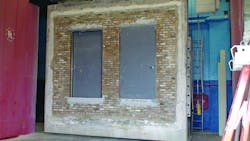An Underwriter Laboratories UL label on a product is often taken for granted, but a lot of things go on behind the scenes in order to merit that coveted label. This reporter has visited the UL laboratories in Northbrook, Ill., on several occasions and has always been impressed with the preparation and expertise of all involved.
HES, Inc. is a manufacturer of electric strikes. After developing a new electric strike, they recently submitted this product to Underwriter Laboratories for testing and allowed us to describe the testing procedure.
The test by UL required an actual installation of an HES strike into a steel door and frame surrounded by brickwork, just as if it were installed in a real building. In order to pass UL tests, installations on both in-swinging and out-swinging doors were required.
A large framework on wheels was used to house the two door frames. Regular concrete block and mortar filled the space around the door frames to complete the installation. Directly behind the concrete wall was a series of gas jets. When ignited, the gas jets could be aimed directly at the steel doors to simulate the heat from a building fire.
Steel doors used for the test were 4 feet wide and 8 feet tall with four hinges per door. Installation of the HES product on this large-sized door allowed the HES UL fire rating to extend to steel doors of any smaller proportions. Standard cylindrical lever locks with a 1/2” throw were used for the test.
RUNNING THE TEST
In order to pass the UL fire test, the HES electric strike had to hold the door in a closed and locked condition for at least 3 hours. After the gas jets were ignited, the temperatures on the door surface were ramped up, eventually reaching a startling 2000 degrees Fahrenheit.
An eye-catching video taken during the UL test shows the doors first darkening in color before finally beginning to belly outward from the overwhelming heat. After a sustained amount of time, the top horizontal part of the door frame also buckled slightly downward because of the extreme heat.
A time clock on the wall clicked off the minutes as the heat was continually applied to the door. As time went on, the top and bottom portions of the door warped outward a considerable amount, but the new HES strike held fast. Heat was being simultaneously applied to the in-swinging and out-swinging doors. Both doors had the same HES electric strike and lever lock hardware installed. As a testament to the searing heat, the lever handles actually drooped slightly, but both the lock and electric strike held in place for the required three-hour time.
The reason for a framework on wheels was evident when the heat testing was completed. UL workers managed to wheel the whole framework containing the heated doors away from the fire area and over to a water spray area. Workers immediately sprayed the heated door surfaces with water in order to simulate the action of a fire hose in an actual fire. In order to pass the test, the doors had to remain locked while sustaining both the cooling water and the water pressure on the door surfaces. Without question, the new HES electric strike passed the test.
This new electric strike will not be available until early fall. Without giving too much away, the new HES strike will fit in a standard 4 7/8” ASA cutout without modifying the frame in any way. All a locksmith must do is run wiring into the existing strike area. Field adjustable voltages and quick-connect wiring to other Assa Abloy products are sure to make this electric strike a winner.
For more information contact your local locksmith distributor or HES, Inc., web site www.hesinnovations.com or telephone 623-582-4626.






